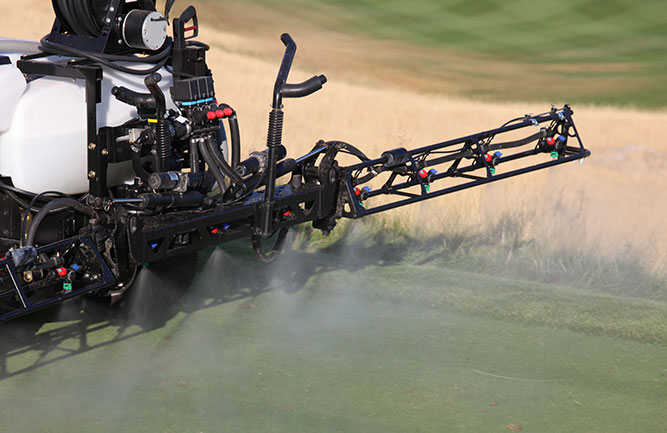Geared up on greens mowers
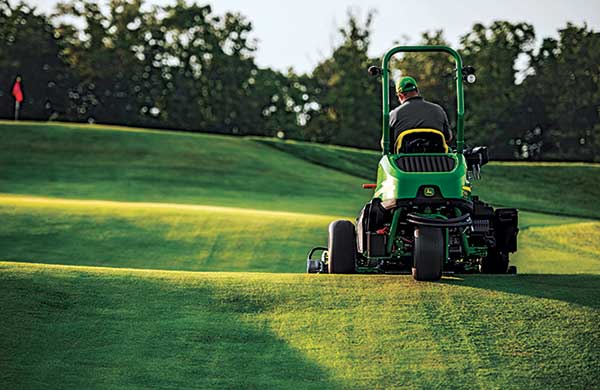
Setting supervisory controls on greens mowers helps take stress off superintendents and operators alike. (Photo: John Deere)
Gone are the days of pulling the ol’ greens mower out of the maintenance shed and relying on — or worrying about — crew members properly calibrating the settings for each application.
Instead, these days, greens mower technology has advanced so far that superintendents can set and lock a wide array of supervisory controls, including the mow speed, transport speed, frequency of clip, raise and lower speed and cleanup pass speed — just to name a few.
“By taking the controls away from the operators, they are able to just concentrate on mowing,” says Tracy Lanier, manager of golf product marketing for John Deere Golf. “It takes some stress off the superintendent because they don’t have to worry about how the machine is going to operate on the course, and it takes some stress off the operator because, especially if they’re not skilled or seasoned, they can still go out there and mow like they’ve been mowing greens for a good number of years.”
Rob Hayward, product training manager at Jacobsen, adds that cut consistency has improved with these innovations, and superintendents can expect the first green to be cut in exactly the same way as the 18th green.
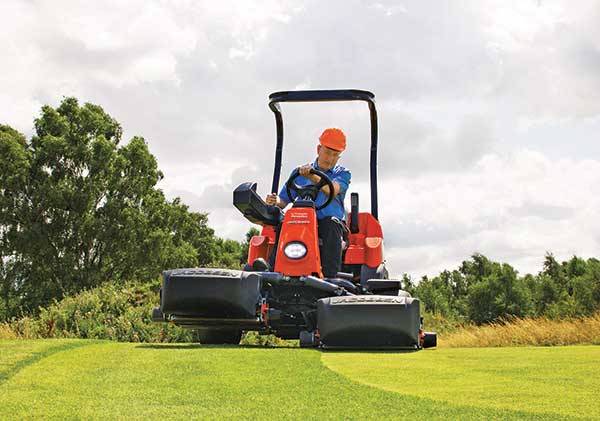
Finding mower operators is a challenge, and advanced greens mowers allow new operators to cut like seasoned pros. (Photo: Jacobsen)
“Greens are a very precise playing surface,” he says. “With operators, you can get a steady operator or one who is a little too enthusiastic. Now, the superintendent can dial in a better quality of cut, or better frequency of cut, and lock that behind a pin number, so it doesn’t matter what the operator does, even if he wants to finish a bit quicker, it’s set to exactly what the superintendent wants. There’s nothing the operator can do to bypass that. Literally, from the first moment that unit is dropped on the green to the last green that’s mowed, it’s the same consistency.”
On the edge of efficiency
Lanier acknowledges that many of the greens mower innovations stem from the labor woes on golf course crews.
“In our interactions with customers, we understood they were having a hard time getting the help to mow greens,” he says. “The staffs were always getting scrutinized as far as budgets, so as the economy got better and it got harder to recruit into the golf course environment, we really needed to take the greens mower to the next level with the 2700 and 2750.”
At Big Cedar Lodge in Ridgedale, Mo., controlling and adjusting the settings helps cut down on the number of headaches for crews and management alike, according to Todd Bohn, director of agronomy.
“The mowers stay on that adjustment, so it cuts down on time for my equipment technicians having to be out in the field with the mowers,” he says. “It ensures you get a good quality of cut, and you don’t have to be out there to babysit your mowers because you know they’re going to be mowing as good as they can be.”
The five-course facility uses a variety of John Deere equipment, including the 2500 triplex greens riding mowers and the 260 walk-behind mowers.
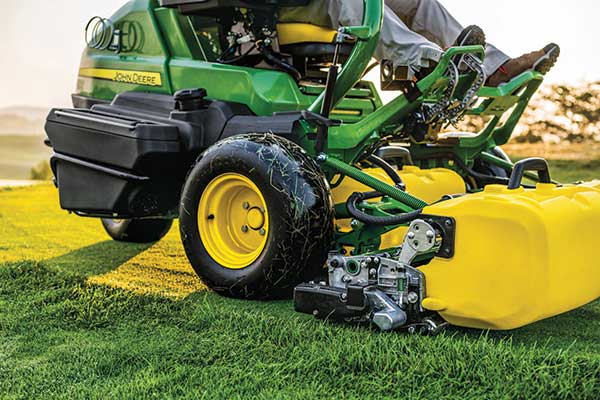
As greens are a precise surface that require attention to detail, ground-following settings help ensure a consistent cut. (Photo: John Deere)
Bohn adds that setting the adjustments also helps when it comes to ensuring prime conditions for the state and local tournament the resort golf club has hosted.
“I always get good comments on how our greens roll and how high of quality the cut is from the players,” he says. “I like how they move with the contours of the greens a lot better.”
Lanier notes that several other superintendents have lauded the importance of setting the ground-following ability on the units.
“As we looked at more customers moving away from a walk greens mower and going to a riding greens mower, we knew they’d need to be able to follow the contours better on the greens so we spent a lot of time taking it to the corner conditions for contour following,” he says.
“Operators can follow the most undulating greens, keeping that cutting unit on the green so they get that nice quality of cut, just like you would with a walk greens mower.”
Pick your position
When it comes down to choosing which settings to adjust and lock, Lanier says superintendents need to think about what they’re trying to accomplish for their course.
“If they are on a course with a lot of surrounding houses and they are mowing greens early in the morning and want to be quiet, they can set the engine mode to the lowest engine RPM setting — that’s about 2,200 RPMs — and it’ll stay at the setting the entire time so the sound level is low,” he says. “In some cases, superintendents are looking at fuel savings, so they can set it in economy mode, and that adjusts the RPMs, so it’s only outputting the power it needs. If they’re out verticutting and need maximum power, there’s a mode to set that up to do the most demanding job.”
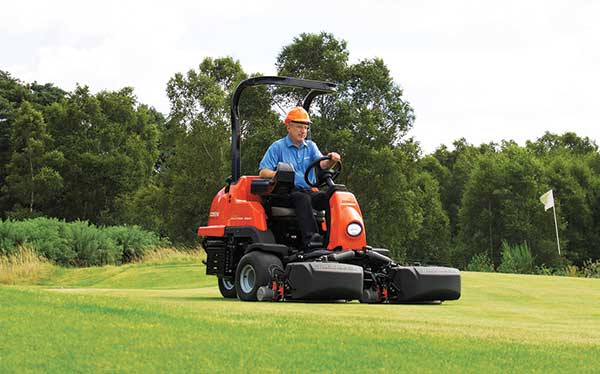
Past battery-powered equipment may have slowed down operators because of recharge time, but lithium technology can make it around a course’s greens three-plus times. (Photo: Jacobsen)
In addition to lockable settings, lithium technology is also stepping up to the plate — or rather, greens — as a new innovation in the greens mower market.
For example, Jacobsen recently partnered up with Samsung and will use the latest version of its battery systems, the Samsung SDI battery, to power the Eclipse 360 machines, which are set to roll out into the market in early 2021.
“Battery technology has been around for a very long time, but it’s the lithium now that is really making a huge difference in the marketplace,” Hayward says. “People are looking at costs, and fuel costs are going up all the time. Lead-acid batteries, while they’re very effective and still in use throughout the world, there’s a certain amount of maintenance needed for them, but with the lithium, the maintenance is zero, they’re lighter and have minimal noise and vibration.”
He adds that with traditional lead-acid batteries, operators haven’t been able to make it around one cut of the course, but with lithium technology, the machines are performing three rounds of mowing, with accessories attached, and they still have some charge left at the end.
“If you think of the practicalities as to how many holes you can complete before you return to the shed for a recharge, in terms of operator efficiency, that’s a huge benefit,” says Simon Rainger, vice president of turf for Jacobsen.
Hayward says the environmental friendliness of battery-powered greens mowers is another factor for superintendents to hang their hats on.
“It’s not just one specific item superintendents are looking at now; they’re looking at the much bigger picture. And, with golf courses being a natural environment, they want to also help that environment, and lower noise and emissions all go toward that end.”









